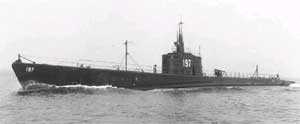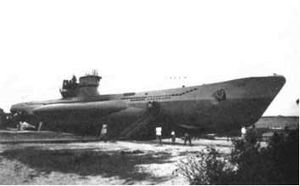Submarines and the War Beneath the Waves
Subs did not originate in World War II—they had been around in crude forms since 1623 when an enclosed rowboat made a trip in London’s Thames River at a depth of 15 feet. Nor did World War II mark their military debut—Germany had proven subs to be a potent weapon 20 years earlier in World War I, using them to sink civilian ships and the ships of neutral nations (most famously, the Lusitania passenger liner). It was during World War II, however, that the submarine reached its height as a weapon, sinking thousands of ships and turning oceans into war zones.
One major role they played was in the Battle of the Atlantic, the name given collectively to conflicts in the Atlantic Ocean. Britain is an island and as such is highly dependent upon trade via the seas that surround it. During the war the route from North America became a lifeline for Great Britain. British ships were relatively safe in American waters and heavily defended British waters. It was on the vast mid-Atlantic where they were most vulnerable to German submarine attacks.
Under the leadership of Admiral Karl Dönitz, Germany used radio messages encoded by Enigma machines to coordinate its U-boats (from the German word for submarine, Unterseeboote) into “wolf packs,” which hunted at night to evade being spotted by the Allies. These tactics, coupled with technological advancements such as an acoustic homing torpedo with directional transducers that would steer the torpedo to a sound source such as the target ship’s propellers, proved very successful, and by the summer of 1942 one Allied ship was being sunk, on average, every four hours. To counter the U-boat threat, the allies began massing cargo ships into convoys and defending them with escorts. Engineers developed new technologies to detect and attack submarines. These included new types of radar, minefields, and magnetic detection.
Subs were important to the U.S from the very first days of the war when they were used to fill the gap resulting from the loss of battleships in the attack on Pearl Harbor. Many submarines were docked in Hawaii, but they were not destroyed in the attack. Initially, the U.S used subs primarily for scouting and reconnaissance. By mid-1942, however, Japanese subs were mostly pulled off combat duties and used for supply runs to the blockaded islands because U.S submarines and carrier aircraft had made the route too hazardous for surface ships. By the end of the war, U.S subs, which had become increasingly reliable and potent throughout the war, had virtually isolated Japan. In some ways, however, Japan had the last word in their submarine fight with the United States—the last major surface ship sinking by a submarine in the war was that of a Japanese submarine attack on the U.S cruiser Indianapolis. Although a tragic loss of men and ship, Indianapolis had already completed its mission—bringing material to Tinian Island, the final assembly point of the atomic bomb.

